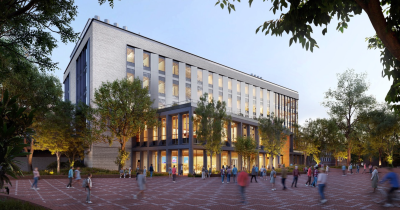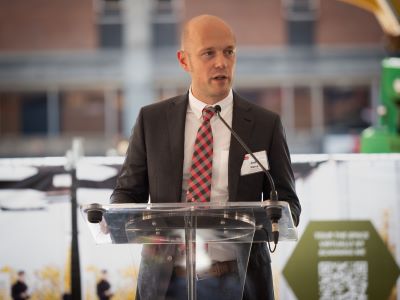
NC State’s Integrative Life Sciences Initiative and Building Support Future STEM Workforce

North Carolina is home to some of the world’s leading life sciences companies, renowned research universities, and workforce development programs to support growing demand for STEM-trained employees. North Carolina State University’s latest project, the Integrative Sciences Initiative and Building, highlights a key strength of the state’s life sciences ecosystem: an understanding of the convergence of disciplines at the heart of life sciences innovation.
On Sept. 8, the university held the groundbreaking for its $180 million Integrative Sciences Building (ISB), which will combine research sciences with real-world experience to prepare students for STEM-focused careers.
“This building breaks down the divide between research and learning,” said NC State Chancellor Randy Woodson. “The Integrative Sciences Building is designed to meet the needs of our ever-evolving disciplines while preparing our students to become skilled, in-demand members of the STEM workforce.”

NC State photo
The building and initiative are a collaboration of the Colleges of Sciences, Engineering, Veterinary Medicine, and Agriculture and Life Sciences.
Joshua Pierce, executive director of the Integrative Sciences Initiative and a professor of chemistry, praised the initiative.
“While chemistry is integral to understanding the properties and behavior of molecules, the translation of molecular solutions into real-world applications necessitates the collaboration of multiple disciplines,” said Pierce. “Fields such as engineering, physics, biology, biomedical science, and computer science complement chemistry by providing diverse perspectives and specialized knowledge.”
Collaboration, Pierce pointed out, extends to humanities and social sciences as well, Pierce said.
“The fusion of these disciplines creates a holistic approach that accelerates the transformation of molecular insights into innovative technologies and solutions with tangible benefits for society,” Pierce added.
NC General Assembly commits $90M to Integrative Sciences Building
Members of the state legislature were on hand for the groundbreaking. Half of the cost of the ISB, or $90 million, will be funded by the state. The university will fund the remaining $90 million.
“The state is investing in our university, and in turn, we are committed to investing right back into North Carolina’s success by fostering innovation and economic advancement and by meeting our state’s demand for a highly knowledgeable STEM workforce,” Woodson said.
Integrative Sciences Research Themes
The ISB will include three core labs where researchers will focus on the study of molecules and the development of molecule-based technologies.
Three research themes will drive early studies and collaboration: molecular mechanisms for metabolism and disease, molecular synthesis and characterization, and molecular therapeutics and discovery. Each theme provides opportunities for researchers and students to collaboratively study, synthesize, and screen molecules and molecular pathways in the context of human and animal disease. A fourth theme focuses on inquiry-based education and workforce development.
The 153,000 sq. ft. facility will be completed in 2026 and will be located on the site of the former Harrelson Hall adjacent to the Brickyard, a gathering spot for students, faculty and community.
